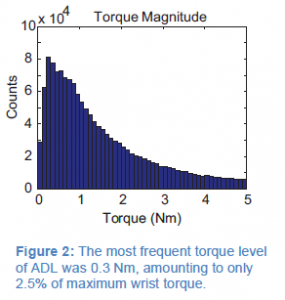Autumn Pando and Dr. Steven Charles, Mechanical Engineering
Introduction
Out of the 75,000 people afflicted with repetitive strain injuries annually in the U.S., 68% impair the wrist1. A major factor in these injuries is abnormal and excessive force. However, forces applied normally by the wrist in everyday environments are unknown. The purpose of this study is to quantify a detailed baseline of healthy, normal wrist forces used in activities of daily living (ADL). Once normal ranges are quantified, abnormal forces can be better identified, leading to more informed preventative designs and more personalized treatment options.
Methods
Eleven subjects (5 male) were recruited for the study. Sensors were attached to the hand and arm, tracking wrist movement and muscle activity in real time (Figure 1). Muscle activity was recorded from the four primary wrist muscles, which control 98% of wrist motion. These muscles are the flexor carpi radialis (FCR), flexor carpi ulnaris (FCU), extensor carpi radialis brevis-longus complex (ECR), and extensor carpi ulnaris (ECU). Muscle activity was recorded by the electrical stimulation in the muscles, known as EMG, which indicates, but isn’t directly proportional to, the resultant force produced by the muscle. In order to determine the EMG-to-force conversion factor, a calibration task was performed prior to the experiment. The conversion factor was scalar and subject-specific. In the experiment, subjects performed 25 ADL, such as hygiene maintenance and food preparation. The data was compounded over all activities and all subjects, yielding results that are averaged for a day’s worth of activities of the wrist.

Results
Muscle activity for each of the primary wrist muscles was compared with their maximum voluntary contraction (MVC; how much force the subject could exert from each muscle). The extensors activated more of their maximum contraction than the flexors (Figure 2). The average force exerted by the muscles was about 70 N for each flexor, 65 N for the ECU, and 125 N for the ECR. The wrist joint utilized low levels of torque. The most frequent torque was 0.3 Nm, and the mean torque was 2 Nm (Figure 3). In comparison, the maximum torque a human wrist can exert is about 12 Nm. More torque was applied in radial-ulnar deviation than flexion-extension for all muscles except the FCR. Co-contraction refers to simultaneous contraction of opposing muscles. It is often used for stability. Co-contraction was applied frequently for all levels of torque (Figure 4).
Discussion
The purpose of this study was to quantify wrist muscle and joint activity during activities of daily living, using healthy individuals with no history of wrist disorders as a norm. The findings will aid investigations of force-induced wrist disorders. Personalized treatments can be better developed, contributing to one of the Great Challenges of Engineering2. Rehabilitation devices, such as wrist orthoses and human-machine rehabilitation interfaces, can be more intelligently designed and improved.
References
- NORA Musculoskeletal Disorders Team, 2001. National occupational research agenda for musculoskeletal disorders: Research topics for the next decade. Cincinnati, OH: National Institute of Grand Challenges. NAE Grand Challenges for Engineering. Accessed 2012 from http://www.engineeringchallenges.org/cms/8996/9129.aspx



